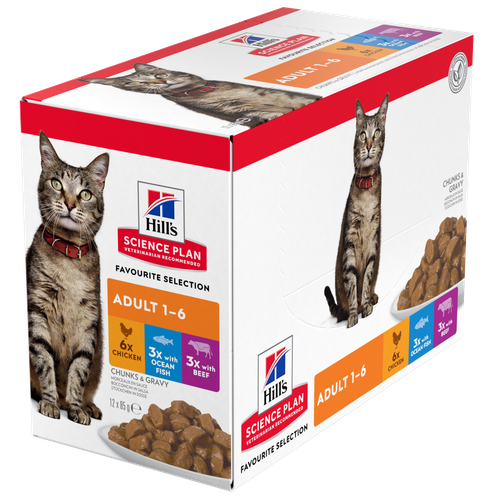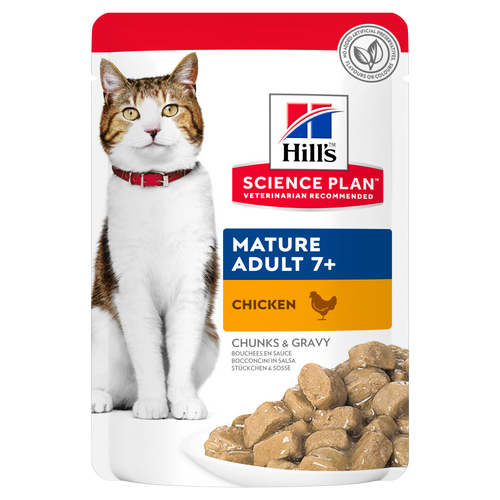
-
Find the right food for your petTake this quiz to see which food may be the best for your furry friend.Find the right food for your petTake this quiz to see which food may be the best for your furry friend.Featured products
 Puppy Food
Puppy FoodHill's Science Plan Puppy Multipack Wet Dog Food with Chicken & Beef are complete premium pet foods for growing puppies from weaning until 1 year old and for pregnant and nursing dogs. Your puppy will love these deliciously smooth and savoury minced loaves, formulated for balanced nutrition and overall health.
Shop Now Mature Adult Dog Food
Mature Adult Dog FoodHill's Science Plan Mature Adult Multipack Wet Dog Food with Chicken & Beef are complete premium pet foods for mature adult dogs from 7 years. Your dog will love these deliciously smooth and savoury minced loaves, formulated to deliver the appropriate amount of energy to support the needs of adult dogs.
Shop Now Adult Wet Dog Food with Beef
Adult Wet Dog Food with BeefHill's Science Plan Adult Multipack Wet Dog Food with Chicken, Beef & Turkey are complete premium pet foods for adult dogs from 1 year. Your dog will love these deliciously smooth and savoury minced loaves, formulated for balanced nutrition and overall health.
Shop NowFeatured products Adult Multipack Wet Cat Food with Beef, Ocean Fish & Chicken
Adult Multipack Wet Cat Food with Beef, Ocean Fish & ChickenTender chunks in gravy for cats, with high-quality protein to maintain lean muscle. With vitamin E and omega-3s & -6s for healthy skin and balanced minerals to support healthy vital organs.
Shop Now Light Adult Multipack Wet Cat Food with Chicken & Ocean Fish
Light Adult Multipack Wet Cat Food with Chicken & Ocean FishTender chicken chunks in gravy for cats, with L-carnitine and fewer calories for ideal weight management. Packed with high-quality protein, omega-6s, and vitamin E for shiny fur and healthy skin.
Shop Now Mature Adult Wet Cat Food with Chicken
Mature Adult Wet Cat Food with Chicken
Tender chicken chunks in gravy for mature adult cats. Made with easy-to-digest ingredients, high-quality protein for lean muscle maintenance and antioxidant vitamins C+E for optimal health.
Shop Now -
Dog
- Dog Tips & Articles
-
Health Category
- Weight
- Food & Environmental Sensitivities
- Urinary
- Digestive
- Joint
- Kidney
-
Life Stage
- Puppy Nutrition
- Adult Nutrition
- Senior Nutrition
Cat- Cat Tips & Articles
-
Health Category
- Weight
- Skin & Food Sensitivities
- Urinary
- Digestive
- Kidney
-
Life Stage
- Kitten Nutrition
- Adult Nutrition
Featured articles The Right Diet For Your Pet
The Right Diet For Your PetIn people, the right diet is very important. If you are eating the wrong way for your metabolism, activity level, age and lifestyle you could end up with health issues.
Read More Show some love with wet foods: a great choice for pets with health issues
Show some love with wet foods: a great choice for pets with health issuesShow some love with wet foods: a great choice for pets with health issues.
Read More The Incredible Science Behind Your Pet's Microbiome
The Incredible Science Behind Your Pet's MicrobiomeLearn what your pet's microbiome is, how it contributes to your pet's gut and overall health, and why nutrition is important in maintaining healthy microbiomes.
Read More -


If you have a cat, you've seen the effort taken to keep fur clean. With this well-groomed exterior you may not notice that your cat has a skin condition.
How to Identify a Problem Right Away
Wondering if your cat has a skin problem? Cat's fur should be clean and fluffy and skin should feel smooth. There should be no redness, lumps, flaking, or any other signs of irritation. If you discover red patches, pimples, scabs, open sores, scaly patches or hair loss, your cat may have a skin condition that needs treatment. Look out for increases in scratching, licking, or itching in certain areas of the body.
Does your cat have an itch? These cat skin conditions may be irritating your favourite feline:
Common Infections
Fungal infections are some of the most typical. Ringworm and yeast infections are two possible reasons why your cat may be experiencing skin problems. Keep in mind they can transfer to other family members quite easily, so early identification is key.
Cats are also prone to parasites and viruses, just as you are. Fleas and mites not only make your cat itch, but both can prove to be a starting point for major skin issues. Even if your cat is not an outdoor cat it is wise to consider flea and tick medicine to help prevent these pests. Ask your veterinarian for recommendations. Certain infections often have side effects of skin irritations. One of those is feline cowpox virus, which the Journal of Feline Medicine and Surgery says cats can get if they've been exposed to rodents that carry the illness. This virus has seen many cases throughout Europe.


Tasty Tips
Environmental Influence
When it comes to cat's skin, the environment can have a three-pronged effect on your cat:
- Environmental allergies: pollen, dust and mould are three common allergens that can lead to cat skin problems. Your veterinarian will be able to help you determine if this is the issue. It's best to keep your cat away from areas that are laden with pollen, dust and mould. Before allowing your cat back into such areas, take all the necessary steps to clean them thoroughly.
- Food allergies: Skin issues are one symptom of a food allergy. Cats who also experience problems with digestion, such as vomiting or diarrhoea , may also show skin problems as another warning sign.
- Medicine: If on medication, it may have an adverse effect, and you may notice skin problems occurring. Contact your vet before discontinuing use or changing medicine.
What You Can Do
You may still be unsure why your cat can't stop licking and itching, and that's fine. Make an appointment with your vet. Your cat may need to be treated with medicine for one of these conditions. It is always important to keep an eye on your cat after giving medicine to ensure that the issue is improving and not worsening. If the issue doesn't slowly start to clear up then there might be other cat skin conditions at play. A vet check-up will help ensure your cat is geting the care needed. Take a list of all of the symptoms you have noticed to help your veterinarian diagnosis the skin irritant.
You love your cat and hate to see them uncomfortable. Even though cats are great self-groomers, you should check fur and skin regularly for any possible issues, and keep an eye out for changes in smell, itching, and cleaning routine. The sooner these issues are addressed, the better your cat will feel.


Erin Ollila believes in the power of words and how a message can inform—and even transform—its intended audience. Her writing can be found all over the internet and in print, and includes interviews, ghostwriting, blog posts, and creative nonfiction. Erin is a geek for SEO and all things social media. She graduated from Fairfield University with an M.F.A. in Creative Writing. Reach out to her on Twitter @ReinventingErin or learn more about her at http://erinollila.com.
Related products

Tender chicken chunks in gravy for mature adult cats. Made with easy-to-digest ingredients, high-quality protein for lean muscle maintenance and antioxidant vitamins C+E for optimal health.

Tender chicken chunks in gravy for cats, with L-carnitine and fewer calories for ideal weight management. Packed with high-quality protein, omega-6s, and vitamin E for shiny fur and healthy skin.

Tender chunks in gravy for cats, with high-quality protein to maintain lean muscle. With vitamin E and omega-3s & -6s for healthy skin and balanced minerals to support healthy vital organs.

Related articles

There are three common ways to feed a cat. Each way has its advantages and disadvantages.

Chocolate is known to be poisonous for dogs, but it can also be toxic for cats. Learn why chocolate is bad for cats & what to do if she's eaten it.

Learn how to make homemade cat treats that are healthy for your pet with this recipe from Hills Pet Nutrition.

From essential vitamins & minerals to different types of meat, learn what to look for when choosing the best cat food for your feline.

Put your cat on a diet without them knowing
Our low calorie formula helps you control your cat's weight. It's packed with high-quality protein for building lean muscles, and made with purposeful ingredients for a flavourful, nutritious meal. Clinically proven antioxidants, Vitamin C+E, help promote a healthy immune system.
Put your cat on a diet without them knowing
Our low calorie formula helps you control your cat's weight. It's packed with high-quality protein for building lean muscles, and made with purposeful ingredients for a flavourful, nutritious meal. Clinically proven antioxidants, Vitamin C+E, help promote a healthy immune system.

